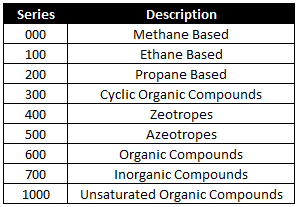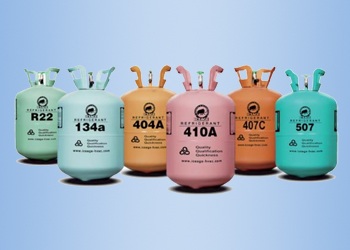Now that you know a little more about the history and general types of refrigerants (I recommend you read Part 1 if you haven’t already) it’s time to get to the really interesting part, refrigerant nomenclature or naming convention. To develop the nomenclature for common refrigerants, ASHRAE developed Standard 34, Designation and Safety Classification of Refrigerants. This standard also provides safety classifications for flammability and toxicity of refrigerants, but this article will concentrate on the naming only.
Refrigerants are named using an “R” (as in Refrigerant) following by a dash and a two to four digit number. Some refrigerants will also have a letter prefix or suffix that further specifies the chemical makeup. Refrigerants are classified into 10 groups called series. These are shown in the table below:

For the first four series (000, 100, 200, 300), the refrigerants are generally a combination of Carbon (C), Hydrogen (H) and Florine (F) with some other elements mixed in here and there. For these series, a very handy trick called the “Rule of 90” applies. With the Rule of 90, you simple take the refrigerant number and add 90 to come up with the number of Carbon, Hydrogen and Florine atoms in each molecule. Here’s an example to demonstrate:

Using this method, we can see that R-22 (CHClF₂) has a single Carbon, one Hydrogen and 2 Florine atoms. It also has a Chlorine, but that isn’t included in the Rule of 90.
Series 400 and 500 are refrigerant blends (mixtures or two or more pure refrigerants). This allows engineers to tweak the refrigerant properties and to make the suitable direct replacements for outlawed refrigerants. These blends are categorized into two blend types, zeotropic (Series 400) and azeotropic (Series 500). An azeotropic blend behaves much as a pure refrigerant would with the entire substance boiling and condensing at the same temperature. In a zeotropic blend, the various refrigerants in the mixtures would boil or condense at difference temperatures giving the substance what engineer’s call “glide.” A more in depth look at glide may be a future column, but is beyond the scope of this article.
The Organic Compounds go in series 600. These are or hydrocarbons and oxygen compounds. Refrigerant numbers are based on the number of Carbon atoms in each molecule. In general, the name is derived from adding the number of carbon atoms to 600 and then subtracting 4.
Series 700 is reserved for the inorganic compounds. Usually a single atom or diatomic molecule (H₂, N₂, etc). These are numbers according to their molecular mass. If the molecular mass is less than 100, you just add the mass to 700 and you have the refrigerant number. For larger masses, you add the mass to 7000 for a 4 digit number.
Lastly, you have a small group of unsaturated organic compounds (Series 1000). An unsaturated (or olefin) compound is similar to the Series 600 organic compounds but has one or more double bonds between the carbon atoms.
As you can see, refrigerant classification and nomenclature is based heavily in the chemistry of the refrigerant, and this article only scratched the surface of all the rules and tricks that go into the names of refrigerants. ASHRAE Standard 34 is the authority on all naming rules and has more information about each series if you are looking to continue reading.
At Forward Engineers, we seek to not only be a design and consulting firm but to also educate our clients about engineering technology. While doing so, we inevitably refresh our own knowledge and sometimes even learn something ourselves. If you are seeking to work with an engineering firm that is client-centered and strives to provides services that are on time, on budget and exceed expectations, please contact us. We would love to work with you on your next project!



